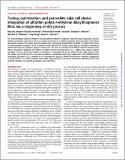| dc.contributor.author | Heydari Gharahcheshmeh, Meysam | |
| dc.contributor.author | Tavakoli, Mohammad Mahdi | |
| dc.contributor.author | Gleason, Edward | |
| dc.contributor.author | Robinson, Maxwell T. | |
| dc.contributor.author | Kong, Jing | |
| dc.contributor.author | Gleason, Karen K | |
| dc.date.accessioned | 2020-03-25T12:51:36Z | |
| dc.date.available | 2020-03-25T12:51:36Z | |
| dc.date.issued | 2019-11 | |
| dc.identifier.issn | 2375-2548 | |
| dc.identifier.uri | https://hdl.handle.net/1721.1/124311 | |
| dc.description.abstract | For semicrystalline poly(3,4-ethylene dioxythiophene) (PEDOT), oxidative chemical vapor deposition (oCVD)enables systematic control over theb-axis lattice parameter ([pi]-[pi]-pstacking distance). Decreasing theb-axis latticeparameter increases the charge transfer integral, thus enhancing intracrystallite mobility. To reduce the barrierto intercrystallite transport, oCVD conditions were tailored to produce pure face-on crystallite orientationrather than the more common edge-on orientation. The face-on oriented oCVD PEDOT with the lowestb-axislattice parameter displayed the highest in-plane electrical conductivity ([sigma][subscript dc] = 2800 S/cm), largest opticalbandgap (2.9 eV), and lowest degree of disorder as characterized by the Urbach band edge energy. Withthe single step oCVD process at growth conditions compatible with direct deposition onto flexible plasticsubstrates, the ratio [sigma][subscript dc]/[sigma][subscript op]reached 50. As compared to spun-cast PEDOT:polystyrene sulfonate, integrationof oCVD PEDOT as a hole transport layer (HTL) improved both the power conversion efficiency (PCE) andshelf-life stability of inverted perovskite solar cells (PSC) | en_US |
| dc.language.iso | en | |
| dc.publisher | American Association for the Advancement of Science (AAAS) | en_US |
| dc.relation.isversionof | 10.1126/sciadv.aay0414 | en_US |
| dc.rights | Creative Commons Attribution NonCommercial License 4.0 | en_US |
| dc.rights.uri | https://creativecommons.org/licenses/by-nc/4.0/ | en_US |
| dc.source | Science Advances | en_US |
| dc.title | Tuning, optimization, and perovskite solar cell device integration of ultrathin poly(3,4-ethylene dioxythiophene) films via a single-step all-dry process | en_US |
| dc.type | Article | en_US |
| dc.identifier.citation | Heydari Gharahcheshmeh, Meysam et al. "Tuning, optimization, and perovskite solar cell device integration of ultrathin poly(3,4-ethylene dioxythiophene) films via a single-step all-dry process." Science Advances 5 (2019): easy 2014 © 2019 The Author(s) | en_US |
| dc.contributor.department | Massachusetts Institute of Technology. Department of Chemical Engineering | en_US |
| dc.contributor.department | Massachusetts Institute of Technology. Department of Electrical Engineering and Computer Science | en_US |
| dc.relation.journal | Science Advances | en_US |
| dc.eprint.version | Final published version | en_US |
| dc.type.uri | http://purl.org/eprint/type/JournalArticle | en_US |
| eprint.status | http://purl.org/eprint/status/PeerReviewed | en_US |
| dc.date.updated | 2020-02-20T14:48:18Z | |
| dspace.date.submission | 2020-02-20T14:48:20Z | |
| mit.journal.volume | 5 | en_US |
| mit.journal.issue | 11 | en_US |
| mit.license | PUBLISHER_CC | |
| mit.metadata.status | Complete | |
